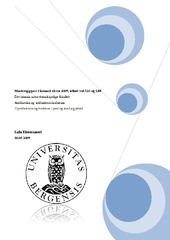| dc.contributor.author | Elmoussaoui, Laila | en_US |
| dc.date.accessioned | 2009-10-22T16:45:35Z | |
| dc.date.available | 2009-10-22T16:45:35Z | |
| dc.date.issued | 2009-05-20 | eng |
| dc.date.submitted | 2009-05-20 | eng |
| dc.identifier.uri | https://hdl.handle.net/1956/3566 | |
| dc.description.abstract | The goal of this thesis was to get a better understanding of how triclosan and ciprofloxacin behave in the environment, and also to see if a contamination of these substances exists in a variety of matrixes. The objective for this thesis is: to establish an analyses method for triclosan and ciprofloxacin and to use the methods to determine the decomposition rate under anaerobe and aerobe conditions. The method of analysis that is used for respectively triclosan and ciprofloxacin is Gas chromatography-mass spectrometry with selective ion monitor (GC-MS-SIM) and High-performance liquid chromatography (HPLC) with fluorescence detector. The experiment with triclosan showed good results when hexane was used as the extraction solution and GC-MS instrument with selective ion monitoring to detect the substance. Method development for ciprofloxacin analyses presented several interesting challenges. Manure as a matrix was easier to work with then soil, but soil with a pH of 2, and a cleanup with silica gel, yielded better results. Soil as a matrix led to difficulties under the test, this was because of the soils contents of other polar components that interfere with the analysis. This made analyses with the HPLC instrument with fluorescence detector difficult. Variance in pH in the eluation solution when cleanup with silica gel was carried out, gave differences in reclamation appease, where a low pH of 0.9 and a high pH of 11.0 gave the highest percentage of reclamation. | en_US |
| dc.description.abstract | Hensikten med oppgaven var å oppnå økt innsikt i, og å øke forståelse for hvordan triclosan og ciprofloxacin oppfører seg i miljøet, samt å undersøke om en eventuell kontaminering av disse substansene eksisterte i ulike typer matriks. Problemstillingen i denne oppgaven er: Å etablere analysemetode for triclosan og ciprofloxacin og å anvende metoden til å bestemme nedbrytningsraten under anaerobe samt aerobe forhold. Analysemetodene som brukes for henholdsvis triclosan og ciprofloxacin er gasskromatografi med massespektrometri med selektiv ionmonitorering (GC-MS SIM) og høytrykk væskekromatografi (HPLC) med fluorescensdetektor. Forsøket med triclosan gav gode resultater når man benyttet heksan som ekstraksjonsmiddel og GC-MS instrument med innstilling på selektiv ion monitorering (SIM). Metodeutvikling og opparbeiding av ciprofloxacin analysen gav flere interessante utfordringer. Husdyrgjødsel var lettere å ekstrahere enn jord som matriks. Men jord som matriks med pH justering til 2 og opprensing på silikagel gav bedre resultater enn husdyrgjødsel med samme prosedyre. Jord som matriks førte til vanskeligheter under forsøket, dette på grunn av dens innhold av andre polare komponenter som førte til interferens. Analyse på HPLC instrument med fluorescensdetektor ble dermed vaskeligere. Ulik pH i elueringsmiddelet ved opprensing med silikagel viste forskjeller i gjenvinning av ciprofloxacin, hvor pH-verdi på 0,9 og 11,0 gav høyest prosentvis gjenvinning. | en_US |
| dc.format.extent | 1674071 bytes | eng |
| dc.format.mimetype | application/pdf | eng |
| dc.language.iso | nob | eng |
| dc.publisher | The University of Bergen | eng |
| dc.subject | Triclosan | nob |
| dc.subject | Ciprofloxacin | nob |
| dc.subject | Gasskromatografi | nob |
| dc.subject | Massespektroskopi | nob |
| dc.subject | Fluorescensdetektor | nob |
| dc.subject | HPLC | nob |
| dc.subject | Nedbrytningsforsøk | nob |
| dc.title | Antibiotika og antibakteriellsubstans, ciprofloxacin og triclosan i jord og husdyrgjødsel | nob |
| dc.type | Master thesis | |
| dc.rights.holder | Copyright the author. All rights reserved | |
| dc.rights.holder | The author | |
| dc.description.localcode | MATF-FARM | |
| dc.description.localcode | FARM399 | |
| dc.subject.nus | 737101 | eng |
| fs.subjectcode | FARM399 | |
